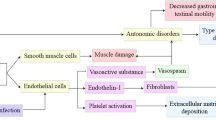Abstract
The predictive value of esophagus-related symptoms for the diagnosis of esophageal dysmotility induced by systemic sclerosis (SSc) was prospectively evaluated in 50 consecutive patients with SSc. Patients were classified as symptomatic when either dysphagia or repeated episodes of heartburn were present. All patients underwent esophageal manometry; SSc-induced esophageal dysfunction was diagnosed when there was aperistalsis or marked hypocontractility of the distal two-thirds of the esophageal body. Twenty-nine patients (58%) had a history of esophagus-related symptoms, while 21 patients (42%) were asymptomatic. Compared to esophageal manometry, esophagus-related symptoms had a sensitivity of 64%, a specificity of 52%, a negative predictive value of 50% and a positive predictive value of 62% for the diagnosis of SSc-induced esophageal dysfunction. In conclusion, the association of esophagus-related symptoms and esophageal motility pattern is poor. As clinical management strategies depend on proof of esophageal dysfunction, screening examinations are mandatory in all patients with SSc.
Similar content being viewed by others
Author information
Authors and Affiliations
Additional information
Received: 30 January 1997 / Accepted: 21 April 1997
Rights and permissions
About this article
Cite this article
Lock, G., Zeuner, M., Straub, R. et al. Esophageal manometry in systemic sclerosis: screening procedure or confined to symptomatic patients?. Rheumatology International 17, 61–66 (1997). https://doi.org/10.1007/s002960050010
Issue Date:
DOI: https://doi.org/10.1007/s002960050010




